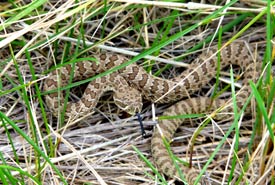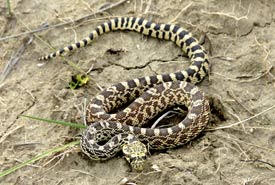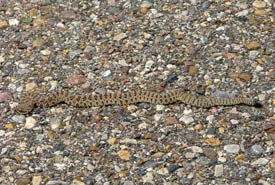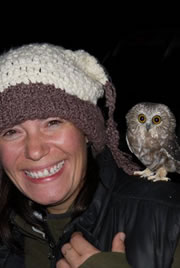Give a hiss on World Snake Day

A prairie rattlesnake neonate - note the triangular shaped head and yellowish-green colouration.(Photo by Wonnita Andrus/NCC staff)
The sun is just beginning to crest the grassland coulee slopes of Lethbridge, Alberta, but I have already been hiking for an hour. I am on the search for one of Alberta’s most feared predators. Its perfected greenish-yellow camouflage and elusive behaviour is hiding it well amongst the sage brush and knee high grass. With careful steps I listen as the world around me awakens: the twittering of vesper and Savannah sparrows begin the prairie’s morning song accompanied by the last howls of coyotes and of course, the constant thudding of my heartbeat, quickening as I near my destination.
But it is the slow tick-tick-tick, getting faster as I get closer, which really sends my heart to race. Instinctively, the hairs rise on my neck and I pause mid-step desperately scouring the earth around me to determine the source of the sound. Miles away from the nearest house and my car, it is important I do not make a mistake...just in case.
My eyes focus and refocus until finally I see the black flicking tongue testing the air to catch my scent, and narrow cat-like pupils peering out from the triangular scaled head. Finally, I am face to face with the coiled reptile I have been studying for almost two years — the prairie rattlesnake (Crotalus viridis) and much to my excitement, it is not alone. She lies coiled in an old mammal burrow with seven of her offspring, known as neonates, and this finding is an important addition to my data, which is focused on determining the population status of rattlesnakes within the city boundaries.

A bullsnake neonate - note the dark, chocolate-brown barring. (Photo by Wonnita Andrus/NCC staff)
After that first encounter, I went on to find many more prairie rattlesnakes while completing my master’s degree. I consider myself fortunate to have come across hundreds of prairie rattlesnakes, bull snakes (Pituophis catenifer), wandering garter snakes (Thamnophis elegans) and plain’s garter snakes (Thamnophis radix) while wandering Alberta’s prairies and parklands. I have been lucky enough to observe red-sided garter snakes (Thamnophis sirtalis) and the rare western hog-nosed snake (Heterodon nasicus). With the exception of the infrequently reported eastern yellow-bellied racer (Coluber constrictor), I have seen all of the province’s snake species in their natural habitats. As a biologist I consider seeing a snake a marvelous event; however, for many people this experience is an extremely stressful, perhaps even terrifying thing. The question is why?
Of Alberta’s snake species, only the prairie rattlesnake is considered potentially dangerous to humans, with the capacity to deliver a venom-filled bite that, while never having been deadly to any Albertan, can cause discomfort and nausea. However, the prairie rattlesnake’s venom is much lower in toxicity compared to snake species occurring elsewhere, such as in the southern United States. It is estimated that AT LEAST 25 to 50 percent of bites are “dry” which means no venom is actually injected. In addition, not everyone who is bitten will experience symptoms. The degree of effect is dependent on where the bite was located, as well as the age, size and health of the individual who was bitten. So while any snake bite should be treated with appropriate medical attention, the truth is even Alberta’s only venomous rattlesnake is not as dangerous as what some people believe.

Female prairie rattlesnake (Photo by NCC)
If that doesn’t bring you some comfort perhaps this will: Alberta’s rattlesnakes are generally not aggressive and prefer to flee as oppose to attack, making snake bites extremely rare. In fact, rattlesnakes are designed to avoid you. Think about it: their rattle is a loud alarm meant to say, "Hey buddy, please don’t step on me!" and their cryptic colouration helps them hide from predators that want to hurt them. Refraining from touching snakes and watching where you step are the TWO BEST things you can do to stay safe. If you do come face to face with a snake, the solution is simple: stay calm, ensure there are no other snakes nearby that you might accidently step on and then just head off in another direction. That’s it! If you watch closely you will notice that even though the snake may be facing you, it will be doing the exact same things as you are — sensing your location by flicking its tongue rapidly for your scent and then moving away from you towards somewhere safe. Our snakes know that if they get into a tussle with something bigger than them they are likely going to lose!
Long a villain in folklore and throughout history, snakes in general are much more often victims. In a world of disappearing habitat, dangerous roads to cross, contamination in their food and deliberate persecution by humans such as “rattlesnake roundups” and the dynamiting of den sites, it is hard to be a snake these days. And all this when just surviving the winter is tough!

A prairie rattlesnake neonate attempts to cross the road, a potentially deadly endeavour. (Photo by NCC)
Snakes play an important role in controlling rodent populations, as well as feeding on slugs, leeches, ants and many other insects. If we can see past the scales to the heart of the matter, we’ll realize all our snake species play an important and useful role in the food web, while also providing free pest control. Coyotes, foxes, eagles, hawk and owls are just some species that think that snakes make a nice snack, illustrating what an important role they play in Alberta’s ecosystems.
So on this, July 16, World Snake Day I implore you — why not give snakes a break? Or at the very least, next time, please share the road with them…I’ll consider it a personal favour.
References


